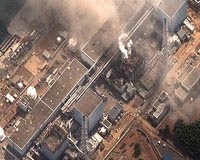 |
Chernobyl Power Station, Ukraine (AFP) April 17, 2011 In the heart of Chernobyl, Ukrainian specialists regularly venture inside the concrete cover sheltering the ruined reactor to check its structure and radiation levels. "We send people in at least once a week," said Volodymyr Kashtanov, the deputy director of the state enterprise in charge of the concrete case, which was built hastily to cover the fourth reactor after it exploded on April 26, 1986. His team's job is to check the casing, known as the sarcophagus, and its contents of around 200 tonnes of nuclear fuel, transformed into highly radioactive magma after the disaster. A few years ago, the sarcophagus was on the point of crumbling, but it has now been considerably reinforced. It is supposed to be replaced in around 2015 by a new steel cover, whose construction began last year. Specialists monitor the safety of the casing and the radioactive materials it contains, some of which are located deep in no-go zones for workers and therefore impossible to control. Before entering, they put on white cotton suits and gloves and disposable outer suits of non-absorbent cloth. They breathe through respirators and carry dosimeters that sound an alarm when they have reached their maximum limit of exposure to radiation. The workers who go inside the most dangerous zones use extra protection: plastic jackets and overshoes, lead aprons and gloves and even oxygen cylinders so they can breath independently. "The only thing we don't have is a spacesuit," joked Kashtanov. To work there, engineers need to show a clean bill of health and to go through special training. "You need to know the safe way to get around inside the sarcophagus," said one of the members of staff, Sergui Sverchkov. In average workers stay inside only 15 or 20 minutes, depending on the level of exposure they have already endured. The welders who stabilised the crumbling sarcophagus worked shifts of just seven minutes, Sverchkov said. "The first man would run over, weld for seven minutes and run back. Then another man took his place." Inside the reactor is completely wrecked, Sverchkov said. "Everything is ruined, in a pitiful state. There are cables hanging down everywhere." Specialists examine the structure, measure radiation levels in the air and check systems to control the dispersal of dust and to drain the contaminated water which builds up from rain, snow and condensation. More than 60 percent of the reactor is still a no-go zone because of high radiation levels or because areas are physically blocked by debris. Workers have drilled holes into such inaccessible areas and inserted radiation sensors and heat detectors which allow them to monitor the situation, which Kashtanov described as "fairly stable." The possibility of another nuclear chain reaction cannot be ruled out, he warned. Nevertheless, the amounts of radioactivity leaking into the air and the soil are "insignificant" and fall within permitted safety levels, he said. Sverchkov admitted that working night shifts in the reactor still gave him the shivers. "We are not really afraid. We know how radiation works. But of course, when you are going on your rounds all alone at night, it is not the most pleasant feeling," he said. "In some places, there is no lighting. You have to switch on a flashlight. And you will hear something bang here or crack there." But another engineer, Igor Kabachenko, responsible for nuclear safety in the sarcophagus, said he had learned to conquer his fears while visiting at least once a week. "After spending two years studying the sarcophagus, my fear has given place to interest," said Kabachenko, adding that he has not experienced any health problems. "I can't imagine working anywhere else. It's like I have an affection for this place," he said.
Share This Article With Planet Earth
Related Links Bringing Order To A World Of Disasters A world of storm and tempest When the Earth Quakes
 25 years after Chernobyl, Japan faces the 'unthinkable'
25 years after Chernobyl, Japan faces the 'unthinkable'Tokyo (AFP) April 17, 2011 When a reactor at the Chernobyl nuclear plant exploded in April 1986, Japan dismissed public concerns over the safety of its atomic facilities, saying a comparable disaster would be "unthinkable" there. Two and a half decades on, a crisis at Japan's Fukushima Daiichi atomic plant has brought fears over the safety of nuclear power back to the surface in a country that still bears the scars of ... read more |
|
| The content herein, unless otherwise known to be public domain, are Copyright 1995-2010 - SpaceDaily. AFP and UPI Wire Stories are copyright Agence France-Presse and United Press International. ESA Portal Reports are copyright European Space Agency. All NASA sourced material is public domain. Additional copyrights may apply in whole or part to other bona fide parties. Advertising does not imply endorsement,agreement or approval of any opinions, statements or information provided by SpaceDaily on any Web page published or hosted by SpaceDaily. Privacy Statement |